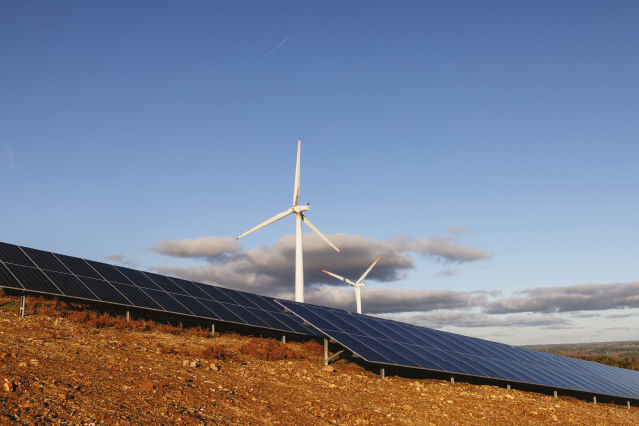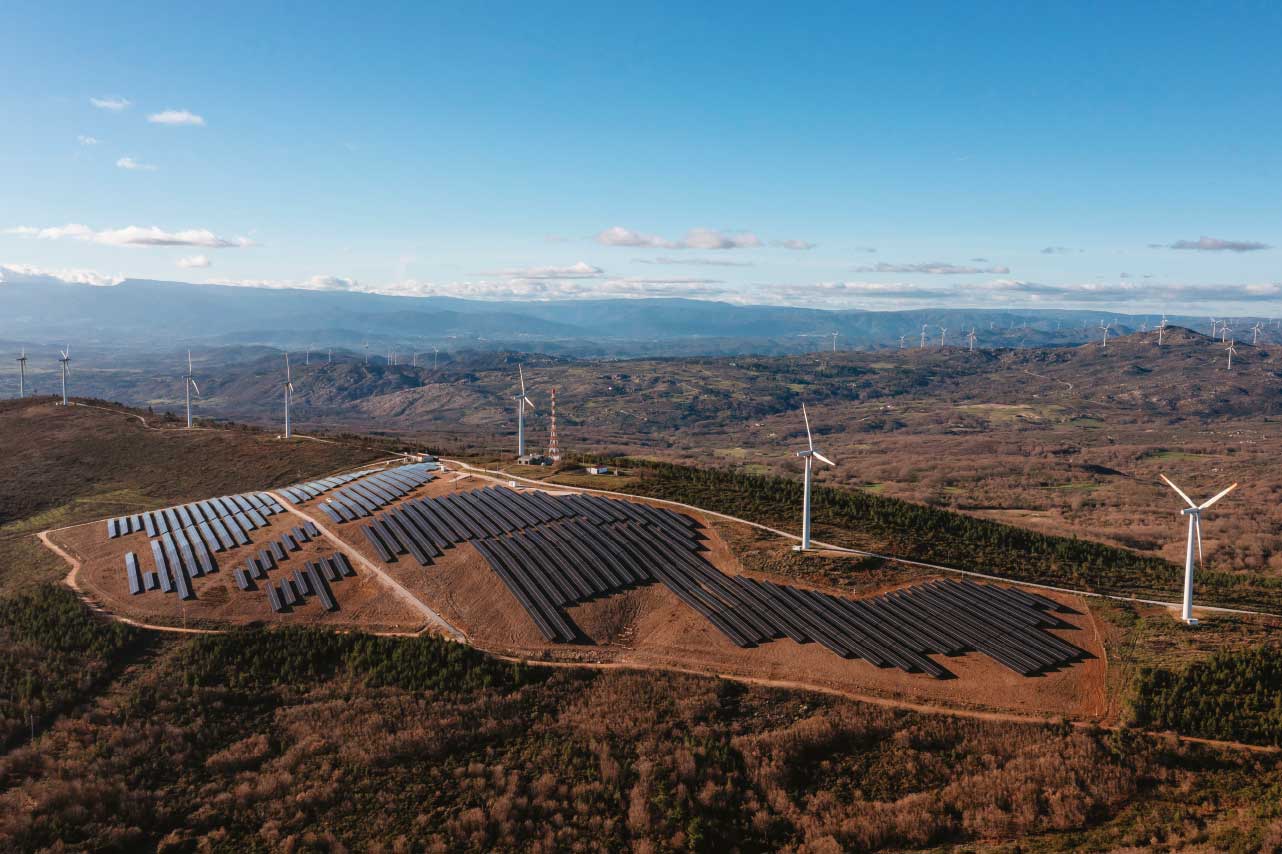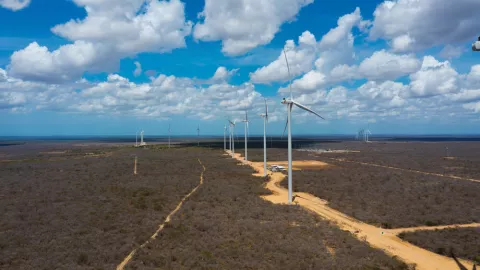Accelerating the energy transition
Hybrid energy systems, which feed electricity generated from two or more renewable sources into the grid, are increasingly becoming mainstream. At EDP, we started blazing this trail nearly five years ago. Last year, at the Alqueva reservoir, in Portugal, we inaugurated the largest floating solar power plant in Europe. This year, in Sabugal, the first hybrid wind-solar power plant on the Iberian Peninsula went into operation.
The first hybrid wind-solar development on the Iberian Peninsula consists of the Mosteiro Wind Farm and the Mina de Orgueirel Solar PV Power Plant. Located only a few kilometers from the center of Sabugal, in the district of Guarda, it will supply renewable energy to more than 30,000 people.
“EDPR’s first hybrid power plant is the result of both our pioneering and innovative spirit and our firm commitment to the energy transition in the main markets where we operate,” says Duarte Bello, COO for Europe and Latin America at EDP Renewables. “With this hybridization, we are increasing the region’s electricity output and minimizing the impact of new renewable projects, since we use existing infrastructures.”
“We are actively developing projects and looking at opportunities to hybridize our wind farms. But we are also working with EDP Produção to hybridize hydroelectric and even combined cycle power plants,” explains Hugo Costa, EDP Renewables’ Country Manager for Portugal. “We currently have about 350 MW in an advanced stage of development, with another 1,000–1,500 MW of other opportunities for the next seven to ten years.”
EDP is planning to invest €25 billion in energy transition projects, and wind-solar hybridization is one of the priorities. More than 1,600 MW in hybrid projects are currently being developed in Portugal and Spain. These are at various stages of maturity and scheduled to come on stream over the next few years.
Visiting EDP’s first hybrid wind-solar power plant
It is here, near the border town of Sabugal, along the Côa River, that EDP Renewables (EDPR) has inaugurated its first hybrid wind-solar project on the Iberian Peninsula.
Travelling along Highway 233 between Sabugal and Guarda, all you can see on either side are mountains. On one of them, in the distance, you catch a glimpse of the eight wind turbines of the Mosteiro Wind Farm, which have been feeding electricity into the grid since 2004. You turn off the highway and continue along a dirt road. After a steep climb up the mountain, you finally see it: a sea of mirrors reflecting the shy, early morning sun. You’ve arrived at the first hybrid wind-solar power plant on the Iberian Peninsula. It is here, between steps and terraces, that EDPR has installed 17,000 solar PV panels. It’s 11 hectares of hilly terrain that had been devastated by wildfires — and more than once. The complex operation, which began in 2022, presented some challenges to EDP’s engineering team.
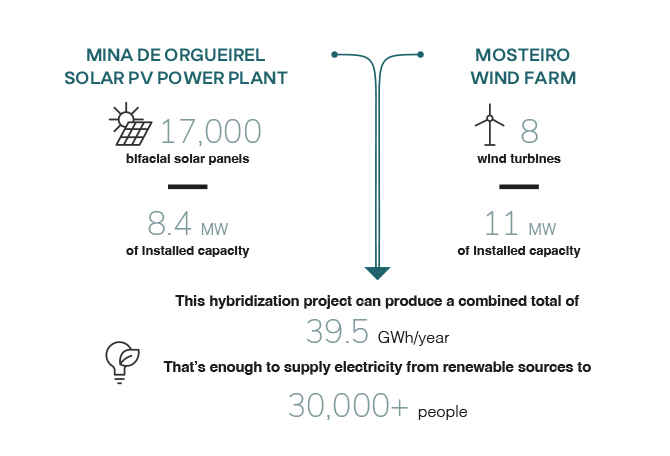
According to Adelino Barbosa, Head of Project Management at EDPR Portugal, areas such as this, “with their ever-changing rock layers, offer up surprises.” And that turned out to be one of the biggest challenges in the construction of this facility. “Halfway through the project we had to change the type of borehole, because the ground hardness was different,” Barbosa recalls. “Those are the kinds of challenges that crop up during the construction, and engineering has to react very quickly so that the project can move forward without damage or loss of equipment.”
From the top of the mountain, the landscape is stunning: you can see the uppermost peaks of the Serra da Estrela, the city of Guarda, and across to Spain. The Côa River cuts through the painting-like scenery. The wind is strong and icy. The turbines dance at breakneck speed, creating their own music. With hybridization, we can produce both wind and solar power at the same time. “Right now [during the morning], we are producing primarily wind power,” says Hugo Correia, who has been Head of Power Plant Operation and Maintenance for 16 years. “Solar power can only generate the difference between what the wind is producing at any given time and 10.5 MW, which is our maximum output.”
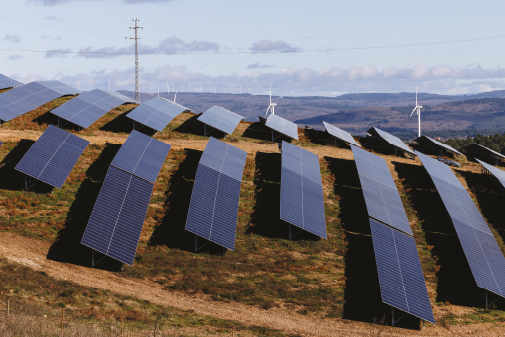
At the top of the mountain, spread out over 1 km, we find the eight wind turbines we had seen from the highway. From up close, their size becomes even more impressive: each one is 56 m tall, the equivalent of a 15-story building.
The Mosteiro Wind Farm has a total installed capacity of 11 MW and already features an even more powerful turbine, installed as part of an over-equipment project. Since coming on stream in 2004, it has already generated more than 350 GWh of clean energy.
Right across from the substation, we find the gate to the Mina de Orgueirel Solar PV Power Plant. Hugo Correia opens the gate for a visit to the sea of mirrors nestled into the mountainside, blending in with the Côa River. “Installing these panels was not an easy task, especially on terrain as steep as this.” Everything was done with the utmost care, from the transportation to the assembly of each panel.
As the day progresses, the wind subsides and the turbine blades slow down. The sun is already high, and most of the power being injected into the grid is now solar. The sun shines on the bifacial solar PV panels, a technology that sunlight to be captured from both sides and maximizes power generation. The entire array has an installed capacity of 8.4 MWp. “These panels have a huge advantage in terms of production. They generate electricity from direct sunlight, hitting the solar cells directly; and from indirect sunlight, reflected from the ground onto the rear of the panels. The more reflective the ground, the more electricity is produced from indirect sunlight,” Adelino Barbosa explains.
All the data generated by this PV power plant is provided by the boxes (called “cores”) found in each row (or “string”) of panels: “The inverters send out signals about the condition of the panels and the amount of energy they are producing,” explains the project manager.
For everything to work perfectly, both the wind farm and the solar power plant require daily maintenance. And that poses additional challenges from a technical and operational point of view. According to Tiago Viegas, Head of Operation and Maintenance at EDPR Portugal, “There are jobs that have to be done on a PV power plant. In this case, because of the steep terrain, maintenance tasks (trimming vegetation, cleaning panels, and even replacing panels and inverters) are a big challenge. It isn’t easy to move around the plant and transport those components.”
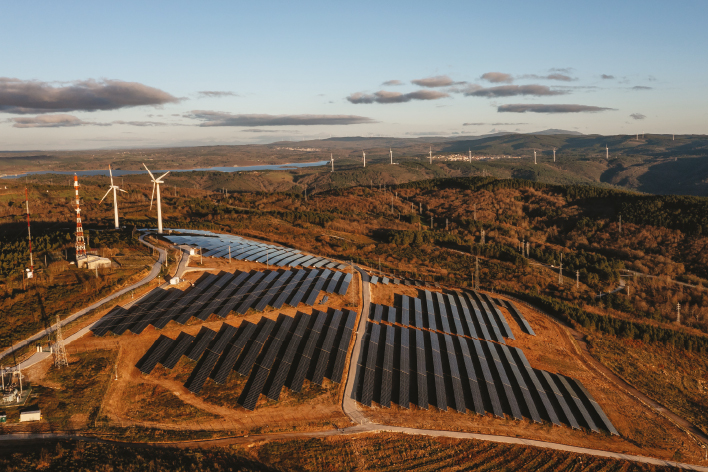
This union between wind and solar is a significant upgrade when it comes to the production of renewable energy. “We have practically doubled the capacity of the power plant by installing the solar project on the same infrastructure as the wind farm. We were feeding into the grid about 25% of our installed capacity and now we are close to 50%. This is obviously a key factor in accelerating the energy transition,” explains Duarte Bello, Chief Operating Officer for Europe and Latin America at EDP Renewables.
This hybridization project can produce a combined total of 39.5 GWh/year, enough to supply electricity from renewable sources to more than 30,000 people. This is clearly beneficial to the residents of Sabugal, says Vítor Proença, the mayor of the town. “Our municipality is committed to renewable energy, to the challenge that we are currently facing, given the current economic situation, and the country’s energy strategy. We are well ahead of the curve when it comes to renewable energy,” he says.
Hugo Costa, EDP Renewables’ Country Manager for Portugal, confirmed that EDPR is also strongly committed to the municipalities that are home to its projects: “Sabugal is no exception and we have a memorandum of understanding with the municipality. We provide significant support — and we hope to step up our relationship in future.”
With regard to the environment, the new hybrid complex will prevent the emission of approximately 18,000 metric tons of CO2 every year. “Hybridization offers huge benefits, both for the power system and for utilities. It increases electricity production and minimizes the impact of new renewable projects by making use of existing infrastructures,” notes Duarte Bello.
“We identified a number of pilot projects to help us understand where we could start. We wanted relatively small but utility-scale projects where we could combine these two technologies. They have different daily production profiles, which helps us in terms of efficiency. The key is the increased load factor,” says Hugo Costa. He explains how the two technologies are combined: “Consider a scenario in which we have a constraint in terms of how much power we can feed into the grid. We have a wind production profile with more output during the night, with a load factor of around 30%, and a solar profile that is the exact opposite, with peak production during the day and a load factor of around 20%. We are able to reconcile the two technologies by increasing the load factor by 20 p.p. for the same feed-in capacity, from around 30% to 50%. So it is a significant efficiency gain without the need for grid reinforcement investments,” he concludes.
And so it is. At the end of the day, as the sun goes down — in a region where the climate is unforgiving, always swinging from one extreme to the other — the blades of the wind turbines start turning faster, and solar power gives way to the wind.
Questions for...
Duarte Bello, COO for Europe and Latin America at EDP Renewables.
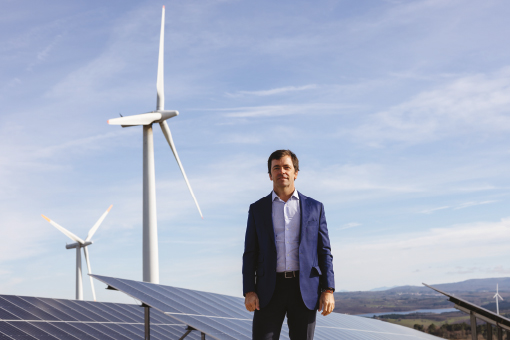
1. Why is this project important?
It has allowed us to double our net power output. With the wind farm alone, we were using 25% of capacity; now, with the solar panels, we are already close to 50%. This is obviously a key factor in accelerating the energy transition, because we are better able to harness the potential of our resources using the same infrastructure. At a time like this, when generating renewable energy is increasingly important, this complex is a symbol of what we are doing in the Iberian Peninsula to use what is already there.
2. How long did it take to build this complex?
This was one of the very first power plant complexes we started to license for hybridization. The licensing process began more than three years ago, but the actual construction began in early 2022 and was finished by the end of the year.
3. What other projects of this nature does EDPR have in the pipeline?
We started this strategy almost five years ago. This is the first complex in the Iberian Peninsula, but we are starting to build another one in Portugal (with an installed capacity of 18 MW) and three in Spain (50 MW). All in all, we will have about 75/80 MW in new capacity. If we consider the synergies with the rest of the EDP Group — with all our hydroelectric power plants, especially in Portugal — we are already looking at a portfolio of 1,600 MW in the Iberian Peninsula. We want to develop that portfolio with hybridization over the coming decade. But although we are moving faster in the Iberian Peninsula, we also have projects in other countries, namely in Poland, Greece, Italy, and the US. And we are looking at hybridization via battery projects, which is a solution that applies in virtually every country.
edpON magazine
Read more on our magazine
edpON magazine is a premium, global, up-to-date publication to enhance the drive, talent and energy within EDP. An element of cohesion for the 13,000 employees worldwide, reinforcing our culture and purpose. And, at the same time, an amplifier of the company's achievements among the external public.
Learn more about the EDP Group hybridization projects in our magazine!

